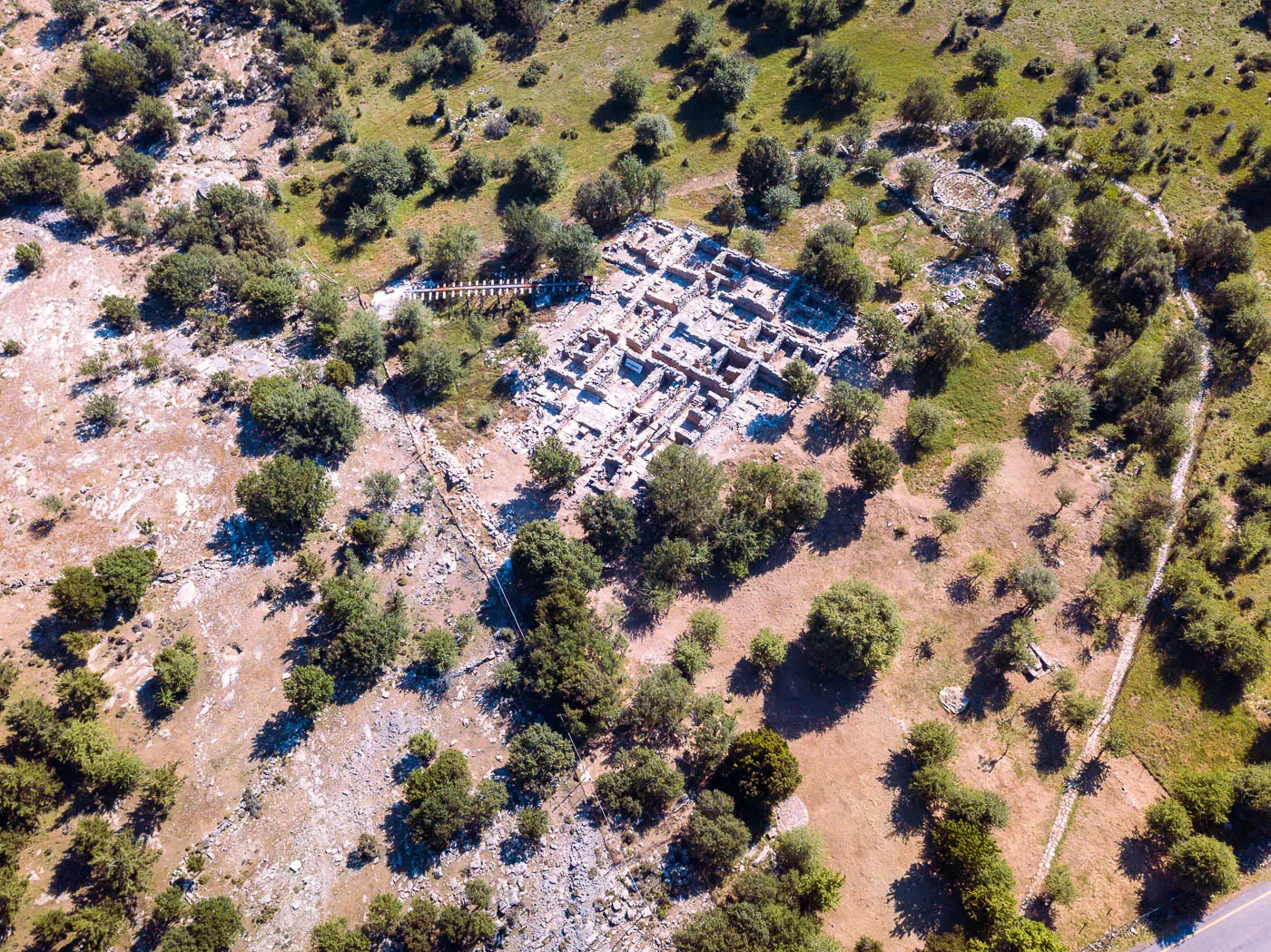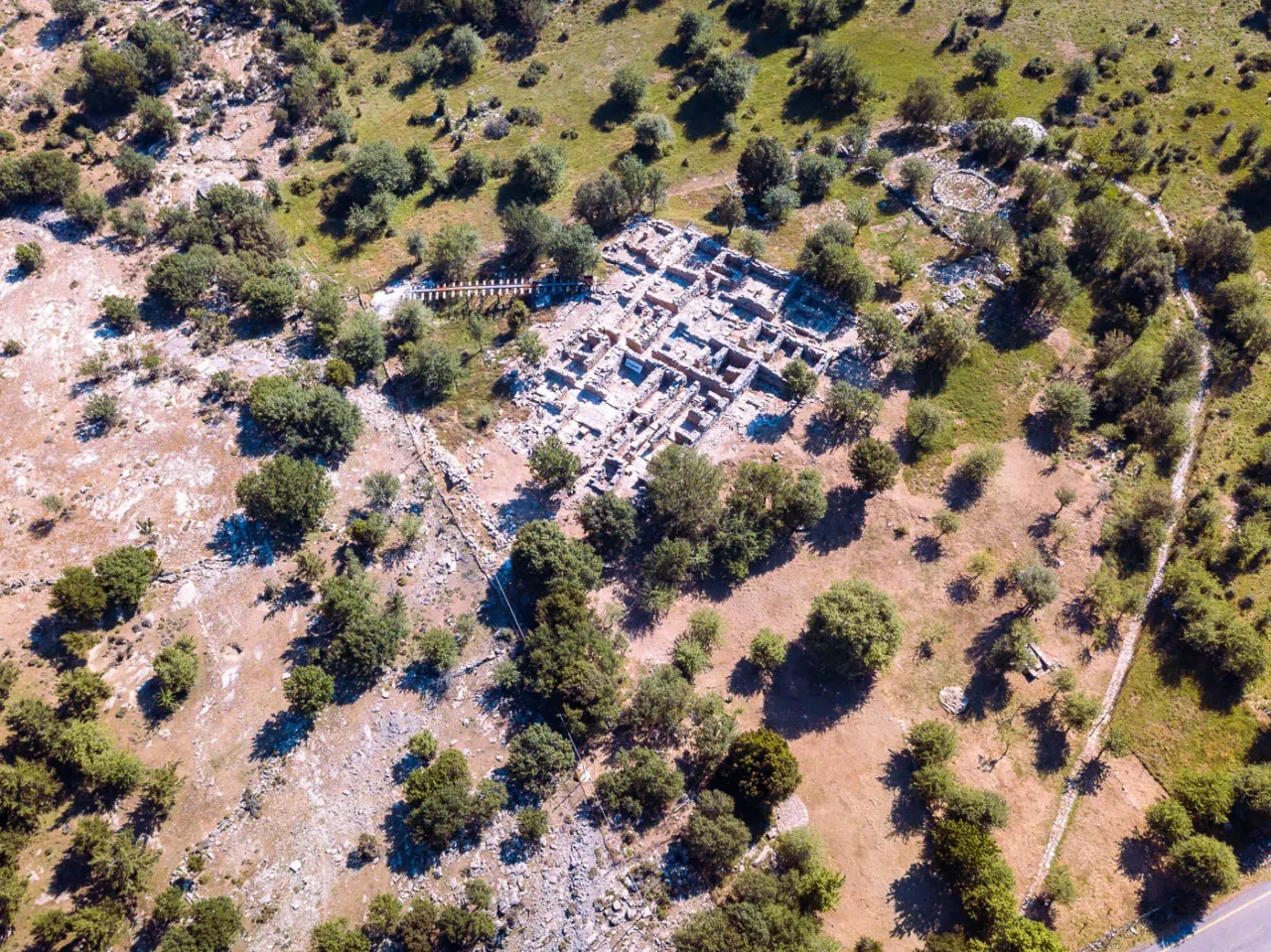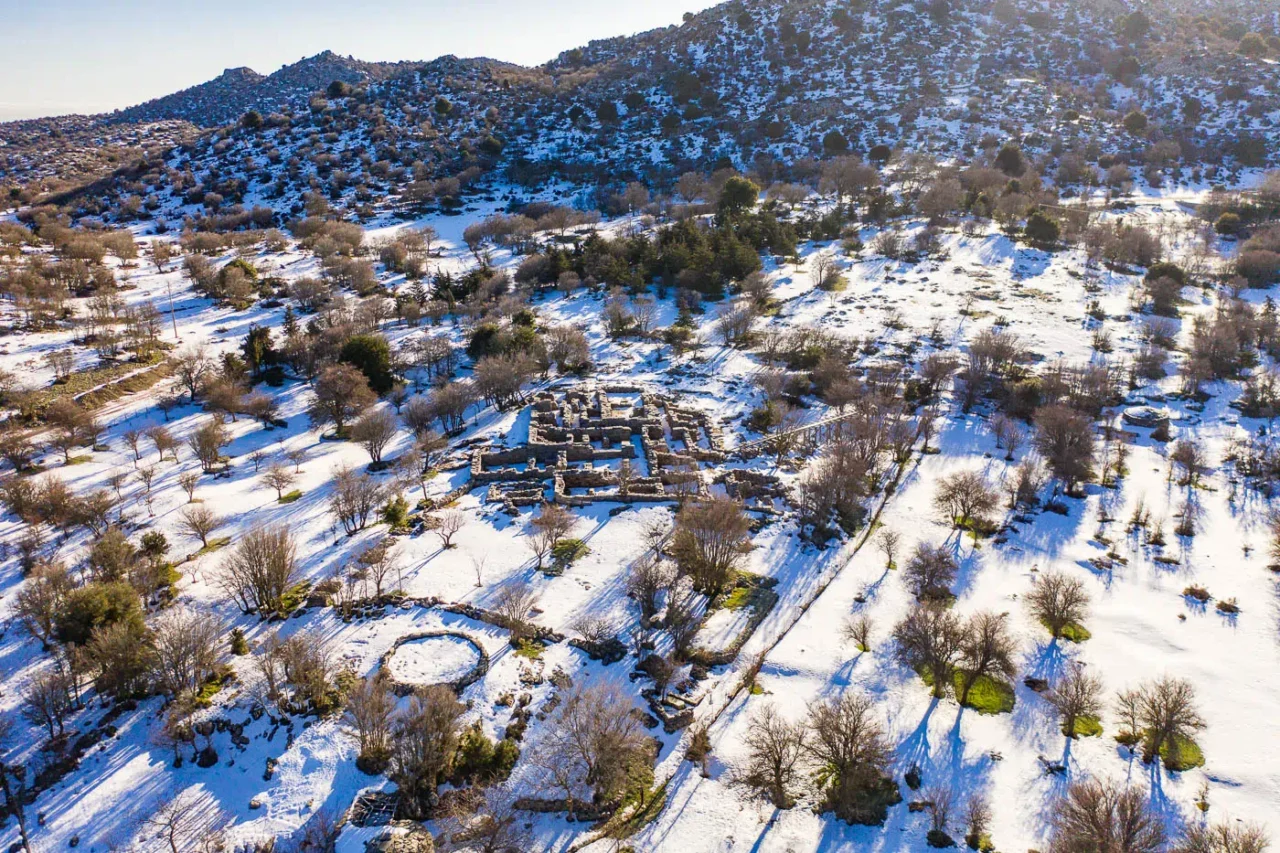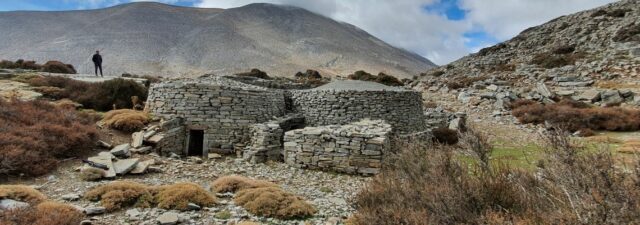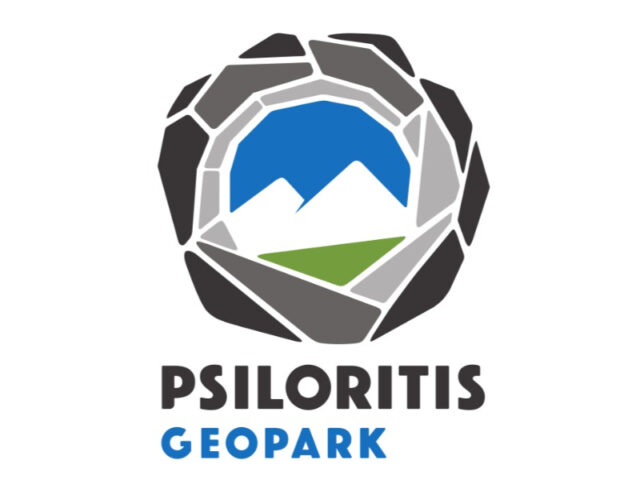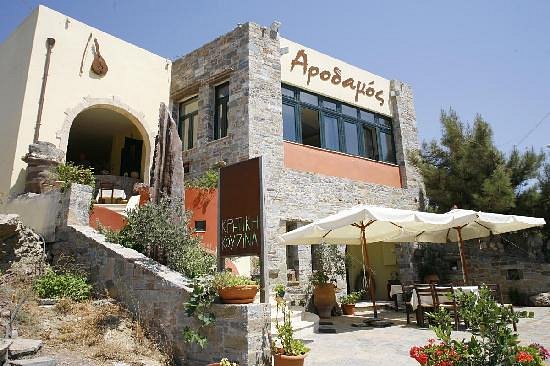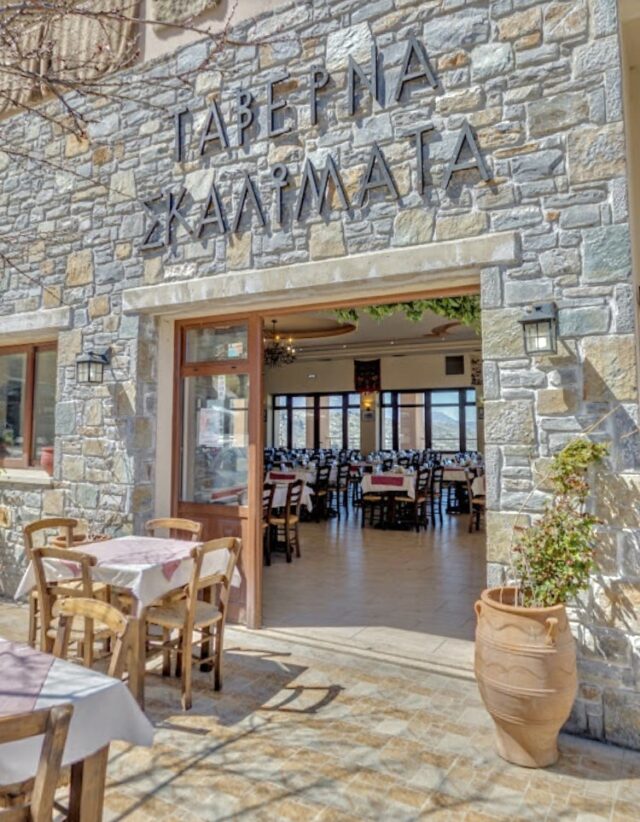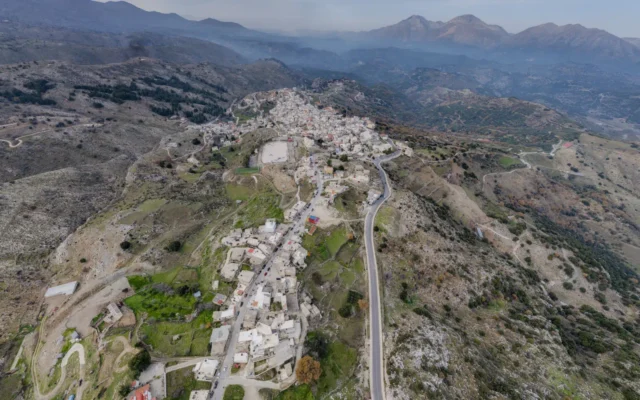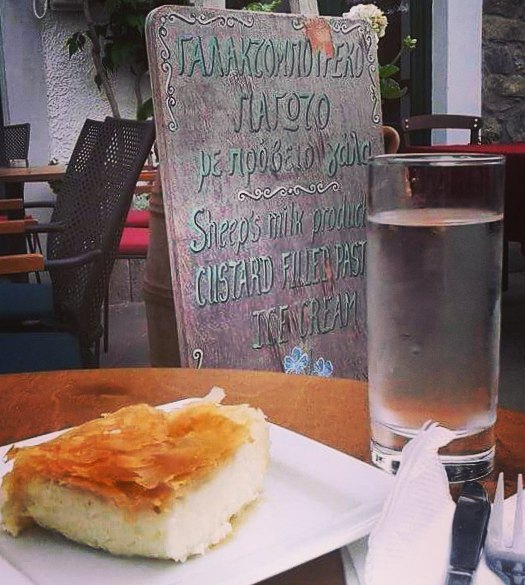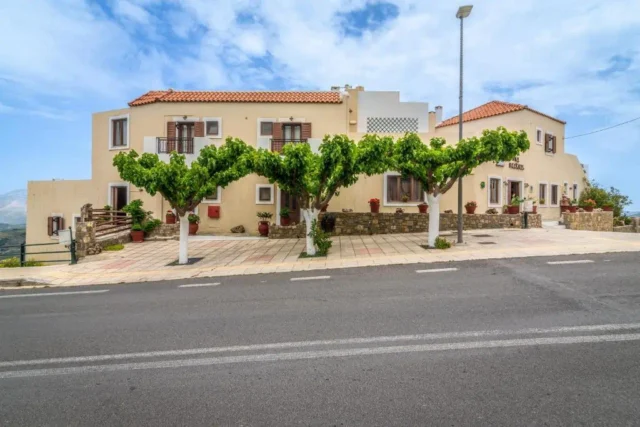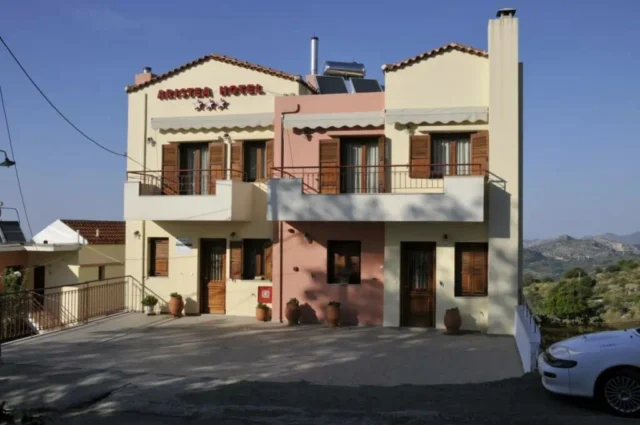The Minoan site of Zominthos is situated in the northern foothills of Mount Ida (Psiloritis), approximately halfway between the modern village of Anogeia and the Ideon Antron (Idaean Cave), at an altitude of 1187 meters above sea level. This location dominates a small upland plain.
The existence of a Minoan site at Zominthos was noted by the late Spyridon Marinatos, who conducted small-scale excavations in the Idaean Cave. However, the systematic discovery of the Minoan ruins at Zominthos occurred in 1982 by Yannis Sakellarakis, following the resumption of archaeological work in the Idaean Cave. An archaeological survey of the region led to the identification of the site, and the first systematic excavation was initiated shortly thereafter.
Historical Periods of Occupation
Late Minoan IA Period
The LM IA period represents the initial major phase of occupation at Zominthos, marked by the construction and flourishing of the impressive Central Building and a surrounding settlement. The Central Building, covering an area of approximately 1,600 square meters, was by far the largest Minoan rural villa known to date, comparable in size to the ‘palaces’ of Petras and Gournia. Its construction utilized large, roughly-hewn blocks of local limestone and incorporated architectural features considered ‘palatial,’ such as a proper north-south orientation and shallow recesses on the western outer wall, reminiscent of the palaces at Knossos, Phaistos, Malia, Zakros, Gournia, and the villa at Makrygialos. The presence of these sophisticated architectural elements underscores the significance of the building. Evidence also suggests that some rooms within the Central Building may have been decorated with frescoes.
The discovery of a pottery workshop in an annex at the northwestern corner of the Central Building is a particularly important aspect of the LM IA occupation. The ceramic assemblage found within this sealed deposit is of paramount chronological significance, likely representing the final phase of pottery production at Zominthos and facilitating a precise dating of the destruction of the Central Building. The pottery from the workshop includes a limited range of shapes, primarily of fine fabric, and exhibits good quality manufacture, although some irregularities are present. Stylistic analysis of this pottery points to a date within the mature LM IA phase, linking it closely with Knossian mature LM IA and both advanced and final LM IA at Kommos.
Beyond the Central Building, surface finds and limited excavations indicate that the settlement surrounding it was considerable, extending over at least one acre. The strategic location of Zominthos at the crossroads of ancient routes leading to the Idaean Cave from the east and northeast further highlights the importance of this LM IA settlement. These routes connected Zominthos with significant Minoan centers such as Tylissos, Sklavokampos, and eventually Knossos, suggesting that Zominthos was well-integrated into the Minoan road network and possibly the “villa-system”.
Late Minoan III Period
Following a period of abandonment after the destruction of the Central Building at the end of LM IA, archaeological evidence suggests a later, limited reoccupation of the settlement during the Late Minoan III (LM III) period. A limited excavation in the location Mnimata, east of the Central Building, revealed remains of LM III structures. However, the extent and nature of this later occupation appear to have been less substantial than the preceding LM IA phase, with the monumental Central Building no longer in use.
Key Historical Events
Establishment during the Neopalatial Period
The foundation of the Central Building at Zominthos occurred during the Neopalatial period, the zenith of Minoan civilization. The emergence of numerous similar rural establishments, conventionally termed ‘villas’ or ‘rural villas’, across the Cretan landscape during this era points to a significant socio-political and economic development. These free-standing buildings, strategically located in the hinterland, are believed to have served to control micro-regions of particular political, administrative, or economic interest. The fragmentation of the Cretan landscape into distinct territories, often defined by natural borders, likely necessitated the dispersal of such centers of authority.
Zominthos, with its commanding position near a rich water source and at the intersection of crucial routes to the sacred Idaean Cave, was likely chosen for its strategic advantages. Some scholars have even suggested that Zominthos may have functioned as a Knossian subcenter in the high mountains, controlling this remote area and the final part of the route to the Idaean Cave. The mountainous region around Zominthos would have provided valuable resources such as timber, cereals, aromatic herbs, and sheep, potentially administered by the Central Building for a larger palatial center like Knossos.
Peak Period in the Late Minoan IA Phase
The LM IA phase represents the peak period of activity at Zominthos, during which the Central Building served as the dominant edifice of a substantial settlement. The sheer size of the Central Building, the largest known Minoan rural villa, and its careful construction, incorporating palatial architectural features, indicate a period of considerable importance and possibly the direct or indirect exertion of central authority. The presence of a pottery workshop producing ceramics of a high quality suggests economic activity was also a significant aspect of this period. The settlement’s role in the communication and potential administration of the routes leading to the Idaean Cave, a major Minoan sanctuary, further underscores its significance during LM IA. It is plausible that Zominthos played a role in specialized pastoralism, given the suitability of the surrounding area for animal husbandry, potentially contributing animal products like meat, milk, cheese, wool, and skin to a wider Minoan economy, possibly under the control of a powerful palatial center.
Destruction at the End of Late Minoan IA
The Central Building at Zominthos met a violent end due to destruction, firmly dated by the associated pottery assemblage to the final stages of the Late Minoan IA period. The fresh pottery found in a sealed deposit within the pottery workshop is of paramount chronological importance, linking the destruction horizon to a specific point in the LM IA sequence, contemporary with mature LM IA at Knossos and advanced to final LM IA at Kommos. The devastating effect of this event left clear traces on nearly every wall of the building, with one wall in Room 11a collapsing in three directions after being severely shaken.
Intriguingly, the destruction of Zominthos in late LM IA coincides with a widespread series of destructions observed at numerous other sites across Crete. This widespread destruction horizon has been convincingly linked by many scholars to the volcanic eruption on Thera (Santorini), which caused the “Volcanic Destruction Level” (VDL) at Akrotiri. The possibility of a contemporary earthquake, potentially triggered by or associated with the Thera eruption, causing the destruction at Zominthos has been suggested. While the exact nature of the destructive event at Zominthos requires further investigation, the synchronicity with other destructions across Crete and in the wider Aegean during the late LM IA is compelling.
Abandonment and Later Reoccupation in Late Minoan III
Following the catastrophic destruction at the end of LM IA, the Central Building and the surrounding settlement at Zominthos were abandoned. The reasons for this abandonment are not explicitly detailed in the sources but could be attributed to the severity of the destruction, rendering the site uninhabitable, and potentially wider disruptions to the Minoan palatial system and settlement patterns that may have been associated with the Thera eruption and its aftermath.
However, archaeological evidence indicates a later, albeit limited, reoccupation of the settlement during the Late Minoan III (LM III) period. Remains of LM III structures were found in the Mnemata area, east of the ruined Central Building. This later phase of occupation appears to have been significantly less extensive and impactful than the preceding LM IA flourishing. The reasons for this later reoccupation could be varied, perhaps due to the strategic location of the site or the availability of resources, even if on a smaller scale. The LM III reoccupation suggests a degree of continuity or renewed interest in the Zominthos area after the major disruptions at the end of the Neopalatial period. The final abandonment of the site occurred sometime after this LM III phase. Future research at Zominthos aims to further elucidate the nature and extent of both occupational phases, the precise cause and effects of the LM IA destruction, and the reasons behind the subsequent LM III reoccupation.
Archaeological Discoveries at Zominthos
- Excavations: Five seasons of small-scale field research were conducted between 1983 and 1990, gradually revealing the Central Building and remains of the surrounding settlement. A planned resumption of systematic archaeological work, directed by Yannis Sakellarakis and Diamantis Panagiotopoulos, began in 2005. Excavations have primarily focused on the northern and northeastern sectors of the Central Building, as well as the western area (Room 21) and the ceramic workshop (Rooms 10 and 11).
- The Central Building: This massive structure covers approximately 1600 square meters, with a maximum length of 54 meters and a maximum width of 37 meters. The ground level consists of more than 40 rooms. It is built of large, roughly-hewn blocks of local limestone and incorporates palatial architectural features, including a north-south orientation and shallow recesses on the western outer wall, reminiscent of the palaces at Knossos, Phaistos, Malia, Zakros, Gournia, and the villa at Makrygialos. The building stands to a considerable height, with parts preserved up to 2 meters or more.
- The Settlement: Surface finds and tests indicate a settlement of considerable size, extending over one acre, surrounding the Central Building. Archaeological evidence suggests at least two occupational phases within the settlement, dating to LM IA and LM III.
- The Cemetery: A rock shelter on the summit of the low hill Spiliari, about 500 meters south of the Central Building, served as the settlement’s cemetery. Human bones, fragments of burial containers (pithoi and larnakes), pottery, and other small finds have been discovered here.
- The Ceramic Workshop: Located in Rooms 10 and 11 of the Central Building, the discovery of a ceramic workshop is particularly significant. The well-preserved state of the workshop, with its installations and contents, offers unique insights into Neopalatial pottery production. Analysis of the pottery from this workshop is crucial for understanding the relative chronology of Late Minoan Crete and the stylistic phases of MM III to LM IB. The pottery includes a variety of shapes, mostly of fine fabric, with medium coarse and coarse pastes also present.
- Notable Artifacts: While detailed lists of artifacts from systematic excavations are not extensively provided in these excerpts, illicit excavations in Room 9 during the 1960s reportedly yielded male and female bronze statuettes that were later sold in Herakleion. The primary focus of the provided material regarding artifacts is on the Neopalatial pottery from the ceramic workshop.
- Current State: The architectural core of the Central Building is remarkably well-preserved. A large amount of fallen upper floor material still lies within the ground floor rooms, presenting both a unique opportunity for studying Minoan architecture and a significant conservation and restoration challenge. The surrounding area remains relatively unspoiled, allowing for potential reconstruction of the Minoan landscape.
Cultural and Economic Context of Zominthos
- Connections to Other Sites: Zominthos occupied a strategic location on ancient crossroads connecting the east and northeast to the Idaean Cave, and further linking the site with important Minoan centers such as Tylissos, Sklavokampos, and Knossos. The northeastern route provided access to Sklavokampos and Tylissos, while the eastern route connected Zominthos with Knossos via Kroussonas and Agios Myron. Evidence of Minoan occupation exists along both routes, including Neopalatial houses and at least one peak sanctuary in the region of Kroussonas, and potential peak sanctuaries near Gonies, Pyrgos, and Keria. The location of Zominthos may have served as a stopping point for pilgrims traveling to the Idaean Cave, a significant sanctuary even in Minoan times. The site is considered a “rural villa,” a type of free-standing building in strategic hinterland locations intended to control a micro-region of political, administrative, or economic interest, often forming the central structure of a settlement. Zominthos‘s size, architecture, and finds suggest it exceeded a private dwelling, indicating authority with political and/or economic power. It may have been a Knossian subcenter in the mountains, controlling the route to the Idaean Cave and the exploitation of local resources.
- Economic Activities: The unusually high altitude of Zominthos (ca. 1200m) suggests a specific economic purpose, possibly related to the control of stock breeding, particularly sheep. The region still offers excellent pastureland. The importance of specialized pastoralism in the Minoan economy is highlighted by Linear B tablets from Knossos that refer to sheep breeding and wool production. Zominthos may have been a summer base for semi-nomadic shepherds or a center for managing seasonal transhumance. The control of this mountainous region’s economic wealth, including timber, cereals, aromatic herbs, and sheep, may have been a key interest of a powerful palatial center like Knossos. The presence of a ceramic workshop indicates local craft specialization and possibly the production of pottery for local use or wider distribution. Dairy production also has a long tradition in the area.
- Cultural Practices: The proximity to the Idaean Cave suggests a strong religious significance for Zominthos, potentially serving pilgrims traveling to this important cult center. The harmonious landscape may have also contributed to its selection as a significant site.
Significance within Crete
- Regional Significance: The discovery of Zominthos has significantly enhanced our understanding of Neopalatial Minoan presence and activity in the mountainous regions of Crete, an area previously less represented archaeologically apart from peak sanctuaries. It highlights the interconnectedness of Minoan sites through road networks and the “villa system,” demonstrating how even seemingly remote locations played a role in the broader administrative and economic landscape of Minoan Crete. The site’s unique characteristics challenge conventional understandings of Minoan settlement patterns.
- Contribution to Chronology: The well-preserved pottery assemblage from the ceramic workshop at Zominthos, particularly the destruction deposit, provides valuable material for refining the relative chronology of the Late Minoan period, especially the transitions between MM III and LM IB. Comparisons with pottery from other sites across Crete, including Knossos, Palaikastro, Malia, and Gournia, help to establish synchronisms and regional variations in ceramic styles. The potential link between the destruction at Zominthos and the volcanic destruction level at Akrotiri offers crucial insights into broader Aegean-wide chronological debates.
- Modern Relevance: Zominthos is located in one of the few relatively unspoiled regions of Crete, offering a unique opportunity to study not only a Minoan site but also a Minoan landscape. Its remoteness allows researchers to investigate the long-term processes of climatic and environmental change with limited modern interference. The ongoing archaeological project aims to reconstruct and preserve the unearthed Minoan remains, contributing significantly to our understanding of Minoan architecture and material culture.
Future Research
Future archaeological work at Zominthos aims to address several crucial questions, including whether the Central Building served as a permanent residence or a seasonal base. A primary goal is the reconstruction of the Minoan landscape through a multi-layered approach combining archaeological, architectural, environmental, geological, botanical, and seismological evidence. Extensive documentation and study of the fallen building material, aided by digital media, will attempt to establish the original state of the structure. The project seeks to further clarify the site’s function within the Neopalatial socio-economic structures and its relationship with palatial centers like Knossos.
Key Points
- Location and Accessibility: Situated at a high altitude (1187m) in the Psiloritis foothills, halfway between Anogeia and the Idaean Cave, strategically positioned on ancient routes connecting major Minoan centers.
- Dimensions: The Central Building is exceptionally large for a “rural villa,” covering approximately 1600 sq. m. with over 40 rooms on the ground floor.
- Active Historical Periods: Primarily occupied during the Neopalatial period, with significant phases in LM IA and a later reoccupation in LM III. The main destruction occurred in LM IB.
- Historical Significance: Represents a unique Minoan presence in a mountainous region, likely serving as a center for economic (pastoralism, resource control) and potentially religious activities, with strong connections to the Idaean Cave and possible administration by Knossos. Its destruction layer provides crucial chronological data.
- Current Status: The Central Building is well-preserved, offering exceptional opportunities for architectural study and landscape reconstruction in a relatively unspoiled environment. Archaeological research is ongoing.
References
- Driessen, J., Langohr, C., 2014. RECENT DEVELOPMENTS IN THE ARCHAEOLOGY OF MINOAN CRETE. Pharos 20, 75–115. https://doi.org/10.2143/PHA.20.1.3064537
- Jusseret, S., Sintubin, M. (Eds.), 2017. Minoan Earthquakes: Breaking the Myth through Interdisciplinarity. Leuven University Press. https://doi.org/10.2307/j.ctt1whm9cf
- Pietro Militello, 2008. Textile Industry and Minoan Palaces, in: Gillis, C., Nosch, M.-L.B. (Eds.), Ancient Textiles: Production, Craft and Society Proceedings of the First International Conference on Ancient Textiles, Held at Lund, Sweden, and Copenhagen, Denmark, on March 19-23, 2003, Ancient Textiles Series. Oxbow Books, Oxford.
- Sakellarakis Yannis, Panagiotopoulos Diamantis, 2006. INTRODUCTORY REMARKS. Originalveröffentlichung in: I. Gavrilaki – Y. Tzifopoulos (Hg.), Mylopotamos from antiquity to the present: environment, archaeology, history, folklore, sociology 47–75.
- Sebastian Traunmüller, 2009. THE NEOPALATIAL POTTERY FROM THE CERAMIC WORKSHOP AT ZOMINTHOS And Its Implications for Minoan Relative Chronology.

